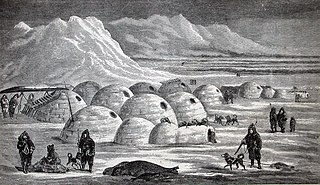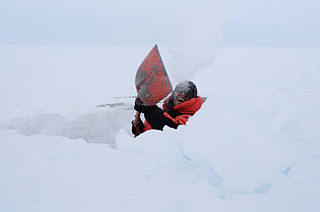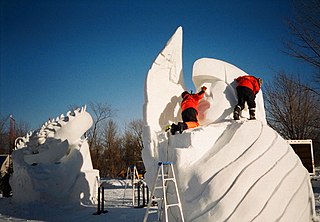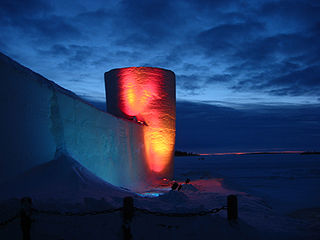 W
WProject Habakkuk or Habbakuk was a plan by the British during the Second World War to construct an aircraft carrier out of pykrete for use against German U-boats in the mid-Atlantic, which were beyond the flight range of land-based planes at that time. The idea came from Geoffrey Pyke, who worked for Combined Operations Headquarters. After promising scale tests and the creation of a prototype on a lake in Alberta, Canada, the project was shelved due to rising costs, added requirements, and the availability of longer-range aircraft and escort carriers which closed the Mid-Atlantic gap the project was intended to address.
 W
WAn ice bar, sometimes associated with an ice hotel is a drinking establishment primarily made of ice. The bars usually contain ice sculptures and other formations and are kept at low temperatures to hinder melting. The walls and seating are also usually made of ice. Mostly a novelty, the ice bar is often considered a tourist destination. Visitors enter for timed stays and even staff work on time-limited shifts. The most popular drinks served at ice bars are ice-cold vodka shots, or cocktails mixing vodka with a berry puree.
 W
WAn Ice Hotel is a temporary hotel made up of snow and sculpted blocks of ice. Ice hotels, dependent on sub-freezing temperatures, are constructed from ice and snow and typically have to be rebuilt every year. Ice hotels exist in several countries, and they have varying construction styles, services and amenities, the latter of which may include ice bars, restaurants, chapels, saunas and hot tubs.
 W
WThe ice nativity scene is an ice sculpture exhibited annually in the Landhaus courtyard in Graz, Austria, during Advent time. The project of a nativity scene made of glaze ice has been a highlight in the town's Advent scene since 1996 and receives international media attention.
 W
WAn ice pier is a man-made structure used to assist the unloading of ships in Antarctica. It is constructed by pumping seawater into a contained area and allowing the water to freeze. By repeating this procedure several times, additional layers are built up. The final structure is many metres in thickness, and strong enough to support container trucks. Operation Deep Freeze personnel constructed the first floating ice pier at Antarctica’s southernmost sea port at McMurdo Station in 1973. Ice piers have been in use each summer season since, at McMurdo's natural harbor at Winter Quarters Bay located at 77°50′S 166°40′E. The harbor is positioned on the southern tip of Ross Island.
 W
WIce sculpture is a form of sculpture that uses ice as the raw material. Sculptures from ice can be abstract or realistic and can be functional or purely decorative. Ice sculptures are generally associated with special or extravagant events because of their limited lifetime.
 W
WThe Icehotel is a hotel rebuilt each year with snow and ice in the village of Jukkasjärvi, in northern Sweden, about 17 kilometres (11 mi) from Kiruna. It is the world's first ice hotel.
 W
WICIUM Wonderworld of Ice is a winter entertainment park built in Levi, Finland from ice and snow. The first park opened on 18 December 2010. The park showcases both ice sculptures and snow sculptures in an area of about 1 hectare.
 W
WAn igloo, also known as a snow house or snow hut, is a type of shelter built of snow, typically built when the snow is suitable.
 W
WMichigan Technological University's Winter Carnival is an annual celebration that takes place every winter in Houghton, Michigan. It is a time to celebrate the large amounts of snowfall Michigan's Upper Peninsula receives each winter. Winter Carnival is characterized by snow statues, outdoor games, and many student activities.
 W
WQarmaq is an Inuktitut term for a type of inter-seasonal, single-room family dwelling used by Inuit. To the Central Inuit of Northern Canada, it refers to a hybrid of a tent and igloo, or tent and sod house. Depending on the season, the lower portion was constructed of snow blocks or stone, while the upper portion used skins or canvas. To the Kalaallit of Greenland, qarmaq refers to the dwelling's wall. Qarmaq were built in the transitional seasons of fall and spring with a circular wall of stone, sod, or blocks of snow, a framework usually made from animal bones, which were covered with a skin.
 W
WA quinzhee or quinzee is a Canadian snow shelter that is made from a large pile of loose snow which is shaped then hollowed. This is in contrast to an igloo, which is built up from blocks of hard snow, and a snow cave, constructed by digging into the snow. The word is of Athabaskan origin, and entered the English language by 1984. A quinzhee can be made for winter camping and survival purposes, or for fun.
 W
WSnice is a portmanteau of snow and ice. It refers to a type of frozen water whose physical characteristics make it an intermediate between snow and ice: snow-ice. The use of snice has become normative in modern ice construction, in buildings such as the winter ice hotels constructed annually in certain arctic nations, and the elaborate ice palace constructions, where it forms the bonding between ice blocks, rather as mortar does between the bricks of a traditional brick-built structure. It is referred to as snow-ice because it has a snow-like appearance, but ice-like physical characteristics.
 W
WA snow angel is a design, made in fresh snow, by lying on one's back and moving one's arms up and down, and one's legs from side to side, to form the shape of an angel. Making snow angels is a common childhood game.
 W
WA snow cave is a shelter constructed in snow by certain animals in the wild, human mountain climbers, winter recreational enthusiasts, and winter survivalists. It has thermal properties similar to an igloo and is particularly effective at providing protection from wind as well as low temperatures. A properly made snow cave can be 0 °C or warmer inside, even when outside temperatures are −40 °C.
 W
WA snow fort or snow castle is a usually open-topped temporary structure made of snow walls that is usually used for recreational purposes. Snow forts are generally built by children as a playground game or winter pastime and are used as defensive structures in snowball fights. They are also built and used for make-believe games such as "house", "store", or "community", a game where multiple forts are built in a group. Along with the snowman, it is one of the two structures commonly built by children out of snow.
 W
WA snow lantern is a hollow cone built of snowballs into which a light is put, usually a candle or a Japanese stone garden lantern Yukimi Gata. People lighting their own snow lanterns is one of Sweden's, Finland's and Norway's Christmas traditions.
 W
WSnow sculpture is a sculpture form comparable to sand sculpture or ice sculpture in that most of it is now practiced outdoors, and often in full view of spectators, thus giving it kinship to performance art in the eyes of some. The materials and the tools differ widely, but often include hand tools such as shovels, hatchets, and saws. Snow sculptures are usually carved out of a single block of snow about 6 to 15 feet on each side and weighing about 20 - 30 tons. The snow is densely packed into a form after having been produced by artificial means or collected from the ground after a snowfall.
 W
WThe SnowCastle of Kemi is the biggest snow fort in the world. It is rebuilt every winter with a different architecture in Kemi, Finland. In 1996 the first snow castle drew 300,000 visitors. For several years the snowcastle was located in the Kemi city harbor. in 2017 the location was moved into a nearby park. Current address is Mansikkanokankatu 15.
 W
WThe Snowking Winter Festival is an annual festival held each March in Yellowknife, Northwest Territories, Canada since 1996.
 W
WA snowman is an anthropomorphic snow sculpture often built in regions with sufficient snowfall. In many places, typical snowmen consist of three large snowballs of different sizes with some additional accoutrements for facial and other features. Due to the sculptability of snow, there is also a wide variety of other styles. Common accessories include branches for arms and a rudimentary smiley face, with a carrot used for a nose. Clothing, such as a hat or scarf, may be included. Low cost and availability are the common issues, since snowmen are usually abandoned to the elements once completed.
 W
WLa statue de la Résistance par Falguière was a 9-foot tall snow sculpture of a nude woman with a cannon made on 8 December 1870 by Alexandre Falguière during the Siege of Paris in the Franco-Prussian War. Falguière was a member of a National Guard company comprising many artists and intellectuals, among them Felix Philipoteaux. Falguière, assisted by his comrades, erected the statue in a few hours, to symbolize French resistance to Prussia. Philipoteaux's sketch of the sculpture was published later that month. It became a tourist attraction, along with a less celebrated snow bust by Hippolyte Moulin near by. Theodore de Banville wrote an ode and Felix Bracquemond made an etching published by Faustin Betbeder. After he snow sculpture had melted, Falguière's attempts to recreate it in a more permanent medium were unsuccessful, lacking the original's spontaneity. It was Falguière's first female nude, a subject in which he later specialised.
 W
WThe World Ice Art Championships is an ice sculpting contest in Fairbanks, Alaska produced on by Ice Alaska, a non-profit corporation started in 1989. The contest is the largest of its kind in the world and attended by more than 100 sculptors from 30 different countries every year. The contest also draws tens of thousands of spectators; in 2004, 48,000 people from more than 28 countries passed through the park's gates.